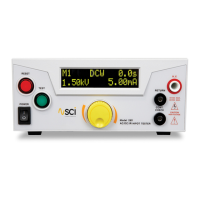hipot.com 40
6. Test Station
Location
Select an area away from the main stream of activity which employees do not walk through in performing their normal
duties. If this is not practical because of production line ow, then the area should be roped o and marked for HIGH
VOLTAGE TESTING. No employees other than the test operators should be allowed inside. If benches are placed back-to-
back, be especially careful about the use of the bench opposite the test station. Signs should be posted: “DANGER - HIGH
VOLTAGE TEST IN PROGRESS - UNAUTHORIZED PERSONNEL KEEP AWAY”.
Power
Voltage-Hipot Test Equipment must be connected to a good ground. Be certain that the power wiring to the test bench
is properly polarized and that the proper low resistance bonding to ground is in place.
Power to the test station should be arranged so that it can be shut o by one prominently marked switch located at the
entrance to the test area. In the event of an emergency, anyone can cut o the power before entering the test area to
oer assistance.
Work Area
Perform the tests on a non-conducting table or workbench, if possible. There should not be any metal in the work area
between the operator and the location where products being tested will be positioned.
Position the tester so the operator does not have to reach over the product under test to activate or adjust the tester. If
the product or component being tested is small, it may be possible to construct guards or an enclosure, made of a non-
conducting material such as clear acrylic, such that the item being tested is within the guards or enclosure during the test,
and t them with switches so that the tester will not operate unless the guards are in place or the enclosure closed. The
outlet which is used to provide power to the tester should be easily accessible.
Keep the area clean and uncluttered. All test equipment and test leads not absolutely necessary for the test should be
removed from the test bench and put away. It should be clear to both the operator and to any observers which product
is being tested, and which ones are waiting to be tested or have already been tested. If the tester is used in a matter not
specied by Slaughter Company, Inc. the protection provided by the tester may be impaired.
Do not perform Hipot tests in a combustible atmosphere or in any area where combustible materials are present.
WARNING
THE MAINS PLUG IS USED AS THE DISCONNECTING DEVICE AND SHALL REMAIN READILY
OPERABLE. THE SOCKET-OUTLET SHALL BE INSTALLED NEAR THE EQUIPMENT AND SHALL BE
EASILY ACCESSIBLE.
CAUTION
Do not replace the power supply cord with an improperly rated cord. For North American: A
UL listed and CSA labeled power cord must be used with the tester in the United States and
Canada. The power cord must include a NEMA5-15 style male plug, SVT or SJT cord sets, and
be rated for at least 125VAC, 10A, number 16 gauge (or 125VAC, 15A, number 14 gauge) wire
or larger, and the length of the cord does not exceed 2 m must be used. For European: A certied power supply cord
not lighter than light PVC sheathed exible cord according to IEC 60227, designation H03 VV-F or H03 VVH2-F (for
equipment mass not exceeding 3 kg), or H05 VV-F or H05 VVH2-F2 (for equipment mass exceeding 3 kg), and be rated
for at least 3G 0.75 mm² (for rated current up to 10 A) or 3G 1.0mm² (for rated current over 10 A up to 16 A) wire or
larger, and the length of the cord does not exceed 2 m must be used.
KEY SAFETY POINTS TO REMEMBER
• Keep unqualied and unauthorized personnel away from the test area.
• Arrange the test station in a safe and orderly manner.
• Never touch the product or connections during a test.
• In case of any problem, turn o the high voltage rst.
• Properly discharge any item tested with DC before touching connections.

